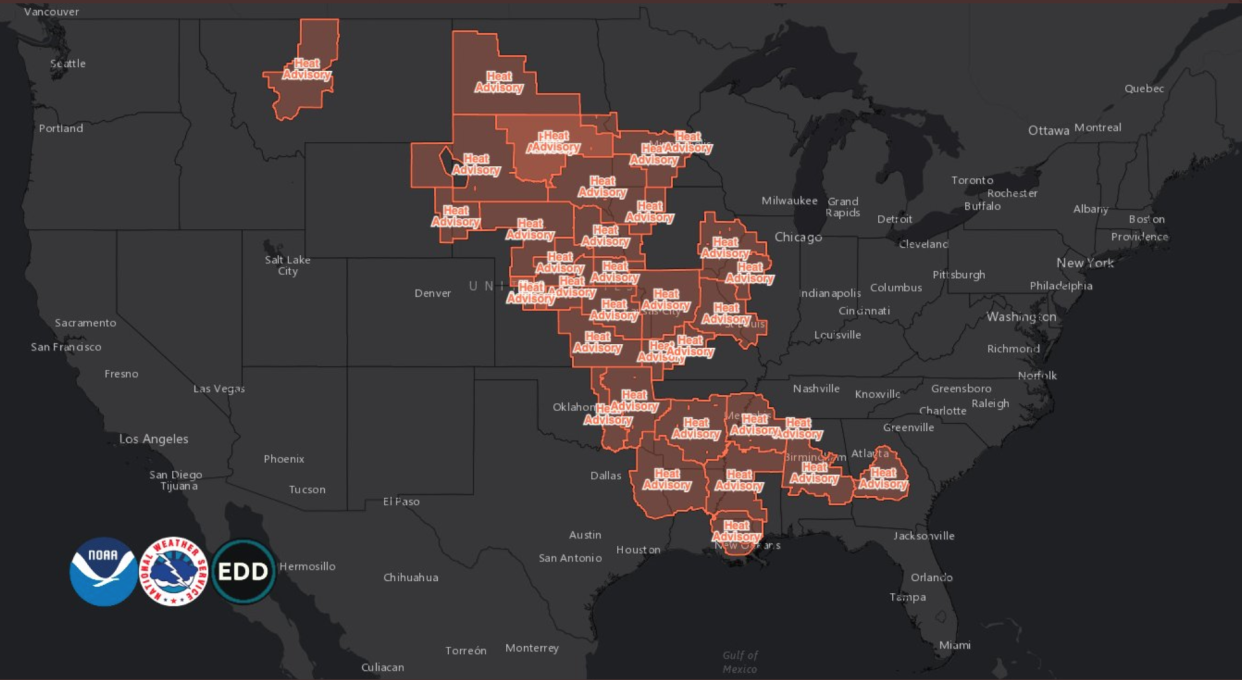Third of US under excessive heat warning weeks after deadly temperatures in West

The Central United States will be “consumed” by high temperatures in the coming days, as the National Weather Service (NWS) issued excessive heat warnings for 17 states.
Stretching from Montana in the North and forming a near continuous line through much of the Midwest and down into Texas, Louisiana and Georgia, a third of the US was under an excessive heat warning on Wednesday morning.
The 40 million people living in affected areas were told to avoid demanding activity during the hottest part of the day.
An excessive heat warning is issued when an area records a heat index of 105 F or greater that lasts for two or more hours, the NWS said.
In Billings, Montana, a new record temperature of 101F was recorded on Monday, beating the high of 100F set in 1959.
In the Northern Plains, which spans much of the Dakotas and Minnesota, temperatures reached 110F on Tuesday.
The hottest parts of the country on Wednesday will be South Dakota and Nebraska, where the temperature is forecast to reach 100F in the state capital Omaha, 12 degrees hotter than the July average, with nearly 50 per cent humidity.
“Try to keep outdoor strenuous activity to the mornings and evenings to avoid the heat of the day,” the NWS Kansas City Twitter account advised.
CNN meteorologist Dave Hennen said about 75 per cent of the US population will experience temperatures in excess of 90F over the coming days, and 32 million people will see highs of above 100F.
The heatwave that has settled over the United States this week has been testing power grids and fuelling dozens of wildfires ablaze across the country.
The hot spell is being caused by a heat dome which has settled over the US, trapping heat in the atmosphere.
Also causing havoc are the more than 85 wildfires that have scorched some 1.5 million acres of land around the US.
Air quality alerts are in place across 13 states from the Northwest to New England, caused by wildfire smoke and the stagnant summer air.
In New York City, an air quality alert was in place until 11pm last night. Experts said it was still safe to head outside, although extra care should be taken.
The alerts cover all of Maine, New Hampshire and Massachusetts and stretch southward to Washington, DC, due to smoke lofted by Canadian fires.
Eight wildfires burning in the Western United States caused pyrocummulus clouds to appear on Monday.
Higher in the atmosphere, smoke is covering almost the entire US.
Idaho has 23 active wildfires, the most of any state, which have so far burned over 192,000 acres.
Last month, an extreme heatwave in the Pacific Northwest caused nearly 100 fatalities, as the soaring temperatures caused power cables to melt and roads to buckle in Seattle.
The extended high ridge is causing concern among firefighters battling the more than 80 major wildfires currently burning across the western United States.
In Texas, the power grid operator said demand would reach a record high over the next week as homes and businesses crank up their air conditioners to battle the heat wave.
Houston reached 97F (36C) on Monday, and is expected to reach the 90s every day between July 22 and August 2.
The state’s power grid failed during a deadly winter storm in February, leaving millions of people without power.
According to the US National Ocean Service, a heat dome occurs when ridges of high pressure become lodged in the Earth’s atmosphere, trapping mountains of warm air beneath them.
In explaining what causes the heat domes, scientists from the National Ocean Service found the main cause was a “strong change in ocean temperatures from west to east in the tropical Pacific Ocean during the preceding winter”.
And according to a new study published this week in Nature, “record-shattering” temperatures are going to become two to seven times more frequent than in the last 30 years.
The new study, published on Monday in Nature, found that if current greenhouse gas emissions continue, heat waves could become 21 times more likely by 2050.
Even after dozens of national record-breaking temperatures in 2021, report co-author Erich Fischer, a climate scientist at ETH Zurich, said: "We haven’t seen anything close to the most intense heat waves possible under today’s climate, let alone the ones we expect to see in the coming decades".
Read More
Frog that became extinct across England is reintroduced to Norfolk
Dozens missing and seven dead after cloudburst triggers flash flood in India’s Jammu and Kashmir
Chances of ‘record-shattering’ heatwaves to soar without urgent climate action, research warns
Heatwaves and forest fires: Why extreme temperatures are so deadly
Four photos reveal terrifying speed of Dixie fire as it grows to six times size of San Francisco

